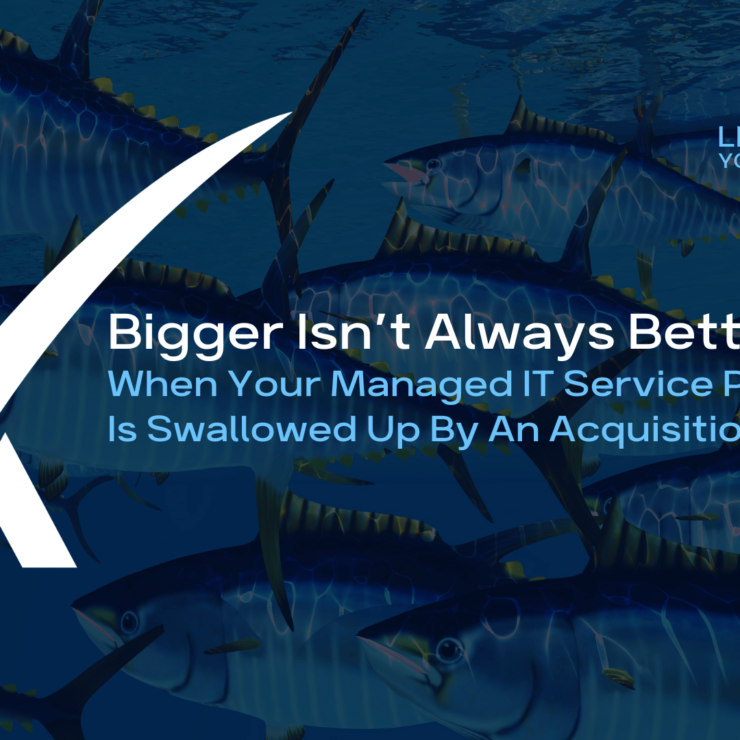Bigger Isn’t Always Better When Your Managed IT Service Provider is Swallowed Up by An Acquisition

When your Managed IT Service provider changes hands in an acquisition, you can expect that there will be some changes in your service. Mergers and acquisitions (M&A) are a common growth strategy found in the Managed Service Provider (MSP) space.
There are two main types of MSP M&As. One type is focused on companies combining forces to create a larger company that can compete on a regional scale. Retaining good customers and employees is an objective and the level of service increases because there’s a larger pool of resources, technical skills and knowledge to draw from.
The other type of M&A involves Private Equity (PE) firms that are focused on developing a regional entity that they can then sell off in 3 – 5 years at a higher premium. With this type of arrangement, the focus is on resale and not service. The result is often that service delivery begins to deteriorate, good employees leave, and IT knowledge and expertise fall behind.
If your MSP vendor has undergone an acquisition and you see service sliding, it’s a sign that your success is not the focus of the new company. Bigger isn’t always better when it comes to meeting expectations for high performing IT.
It’s time to weigh your options if you recognize any of the following signs that you’re not benefiting from an MSP acquisition.
1. IT Becomes Noisy
When IT systems are performing optimally, you hardly notice them, so when you start to hear about more IT issues than you had before, something’s wrong. It’s even worse when you bring those issues to the attention of your new IT provider and they are dismissive of their importance to you.
A decrease in IT performance could mean that the new company is not keeping up with regular maintenance and management. They could have gaps in how they implement industry best practices. Despite their size, they might not have the bandwidth to handle all of their customers and certain customers are prioritized over others.
2. Failure to Meet Service Expectations
Noisy IT wouldn’t be so bad if every time you had an issue it would get fixed, but be wary of increased response time after an MSP acquisition. What happens when IT is slow to respond is that employees get frustrated that technology is roadblocking their work. They lose confidence that IT can or will help them, so they try to fix things themselves or create their own workarounds.
If you have more issues, and the new MSP is taking a long time to solve them, you should ask yourself if you’re really getting all the value that you should from managed services. Managed IT Service providers are supposed to work proactively to prevent issues from turning into big problems. If that’s not happening then there’s a disconnect with what service should look like, compared to what you’re getting.
3. Security and Compliance Issues
If you have a security incident, or even notice an uptick in phishing emails, your new MSP may not be keeping up with security. On the technical side, it can be hard to know exactly what security layers are in place without getting into the technology weeds, but you might notice if there’s more activity raising your suspicions.
Your new MSP should be just as concerned about your non-technical layers of security as they are with firewalls and antivirus. If acceptable use and access policies, and Cyber Security Awareness training are never brought up, then it could be a red flag that the MSP doesn’t have a handle on your needs for cyber risk management or regulatory compliance.
4. IT Guidance is Missing
The way that organizations get the most from their technology is in how IT is leveraged to meet goals. In order to do that, your MSP needs to spend time getting to know your business and processes. Then they should be bringing you ideas on how you can use IT to improve operations.
When your MSP is acquired and you don’t have regular meetings to keep your IT strategy up to date, you risk falling behind. It’s one thing to have an IT plan that improves your network, but IT will have the biggest impact on your business success if you can have an exchange of ideas with your MSP that results in innovative use of technology that sets you apart from your competition.
5. Relationships Aren’t a Priority
If you’ve ever had a great relationship with the people at your MSP, then you will most certainly be dissatisfied if the priority that is placed on relationships is downgraded after an acquisition. If your MSP shares your goals and looks at your success as their success, you’ve got a good foundation for your relationship. When that’s missing, it’s hard to get everyone to paddle together.
What M&A Success Should Look Like
When your MSP has been acquired, it’s not unreasonable to expect to have a transition time when things are a little unsettled but after that you should expect the same or better results that you were getting before – high performing IT that gives your employees a good experience, effectively manages cyber risks and compliance, and is delivered by people who are committed to helping you get the most out of your technology. Anything less than that and it might be time to part ways.
Get a Free IT Consultation
Contact us at XPERTECHS for a free IT consultation. We’d like to learn about your challenges and goals, and help you explore what it would look like to up your game.
